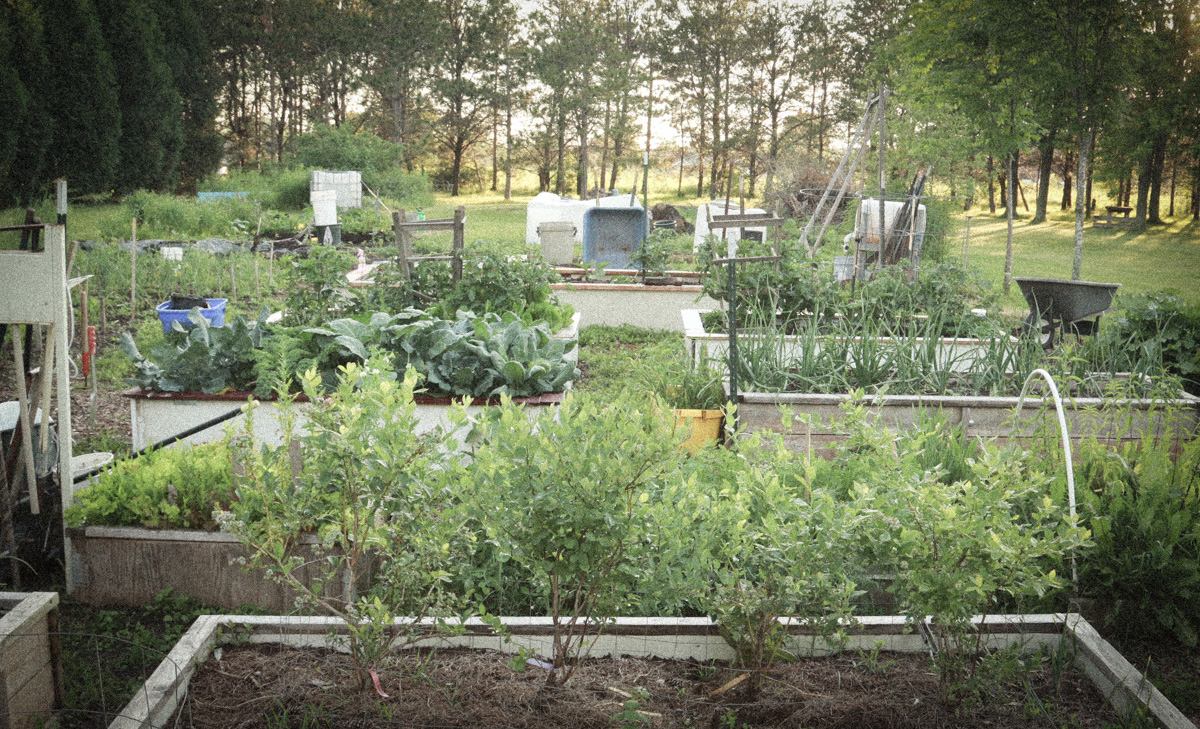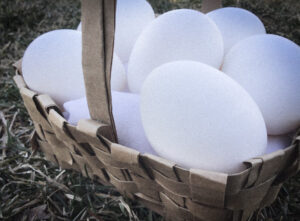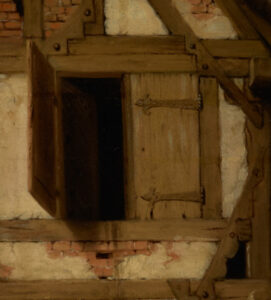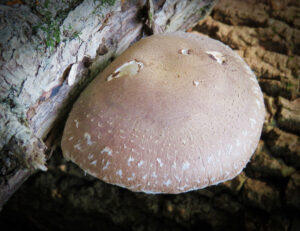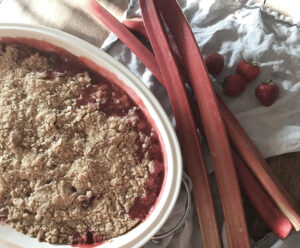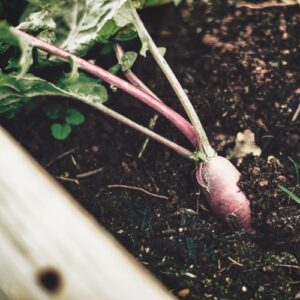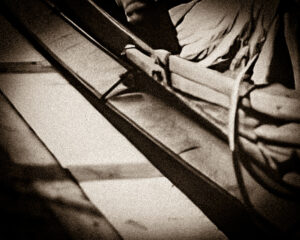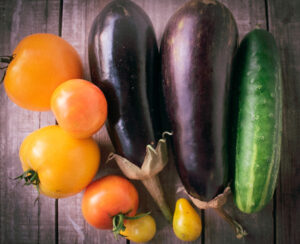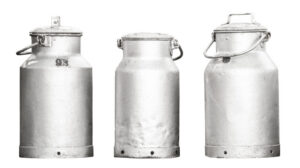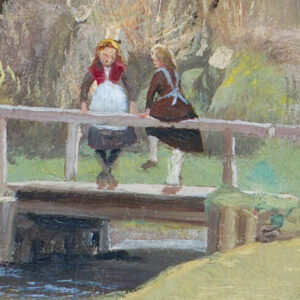One Man's Trash Is Another Man's Raised Vegetable Garden

An Interview with Mr. Rod Runde
When Hearth & Field’s Nathan Runde needed to explore some nuances of raised vegetable gardens, he didn’t have to look far. On a warm afternoon, Mr. Runde cracked open a beer with his father (Mr. Runde Sr.) and plumbed the depths of the elder’s gardening wisdom. Mr. Runde Sr. grew up on a farm and now cultivates a vast backyard homestead. He will proudly take anyone around to show off his garden, orchard, and raspberry patches. Nobody leaves without an armload of produce and possibly some tips and tricks. As of late, he has especially utilized raised gardens, with great success — he has dozens of them, constructed largely out of repurposed refuse.
Mr. Runde Jr.: At it’s core, what is is a raised vegetable garden, and why is it useful?
Mr. Runde Sr.: Basically you just raise the soil up. You don’t necessarily have to have a frame around it. I do my potatoes in hills, and there’s no frame around them. They like moisture, but they don’t like to be wet. So, drainage is one of the big things for your raised beds, especially in a wet year. Here we have heavy clay, so, for example, the corn grows better in a year that’s a little dryer than in a year when it’s a little wetter. If your soil is too wet, the plants don’t get enough oxygen.
Jr: So, a raised bed is just raising the soil, with or without a frame around that soil, and it is really helpful for drainage.
Sr: Yes.
Jr: When did you start gardening in raised beds?
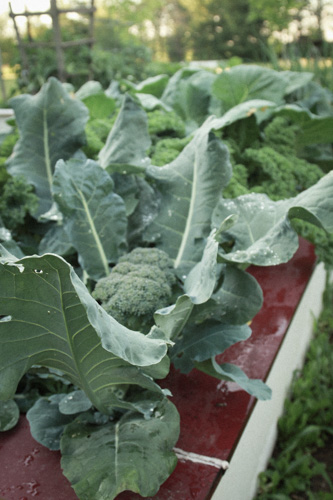 Sr: Well, probably when we moved to Appleton in ‘95. Though in Crystal Lake I had a small garden, and the whole bed was raised a little bit. We were married in ‘87, so I guess that’s when I started. Growing up, my mother didn’t really raise the soil, since she had really good soil that drained anyway.
Sr: Well, probably when we moved to Appleton in ‘95. Though in Crystal Lake I had a small garden, and the whole bed was raised a little bit. We were married in ‘87, so I guess that’s when I started. Growing up, my mother didn’t really raise the soil, since she had really good soil that drained anyway.
Jr: When I was younger, we didn’t have a lot of raised beds. When did you begin primarily gardening in raised beds?
Sr: Well, in just the last couple of years. I built the raised garden for my mom, and that really inspired me, because she had such good results with it; you and McKenna [Mr. Runde Jr.’s wife] filled it! I think that inspired you too.
Jr: It did! So, building the raised bed and seeing the results was what inspired you. Were there other things that inspired you to do the raised beds?
Sr: Well, one thing is that I’m getting older [claps his belly]. It’s hard to bend down for a big guy like me. To sit there and pull weeds is so great. I mean a raised bed is so nice you can just sit down, and it turns weeding from being a chore into just relaxing.
Jr: Drinking your coffee.
Sr: Mmhmm.
Jr: Nice. I was noticing in some of your beds you have a pipe that runs down into the bed, and you explained that the vertical pipe runs into a horizontal pipe with holes in it that runs along a foot-and-a-half beneath the soil of the bed for irrigation. I was really impressed with that idea. Are there other clever tricks that you use with your raised beds?
Sr: Well, the pipe is just something I’m playing with. You know I love to experiment. The pipe will work well for deep-rooted vegetables. It will water them right at their roots.
My thought with doing it that way was that even if it got really super dry, if you’re watering the surface, you’re going to be watering the weeds on the surface too. Whereas if you’re getting the water below the surface, now you’re just getting water to the established plant, not to the weed trying to establish.
Jr: That’s clever!
Sr: I’ll let you know how it works out.
Jr: Do you have any other clever tricks that you use? For example, your friend Marv puts compost in a mesh container right inside the walls of his raised bed so the nutrients in the compost will seep into the soil.
 Sr.: Yup, I do. Not in the raised beds but in the other beds, I do wire baskets and it’s the same idea. You put compost inside a basket made of chicken wire, and then as the compost rots, the roots of the plants right next to it will actually start spreading up into the compost. But then also the idea is that if you have compost in there, you also have food for the worms. The worms will move up into the compost too. Then you get nutrients from the worm castings. What I do then, when I want to water those plants, if it gets really dry, I just pour water in the basket. The roots are already in there so it gets water right to the roots!
Sr.: Yup, I do. Not in the raised beds but in the other beds, I do wire baskets and it’s the same idea. You put compost inside a basket made of chicken wire, and then as the compost rots, the roots of the plants right next to it will actually start spreading up into the compost. But then also the idea is that if you have compost in there, you also have food for the worms. The worms will move up into the compost too. Then you get nutrients from the worm castings. What I do then, when I want to water those plants, if it gets really dry, I just pour water in the basket. The roots are already in there so it gets water right to the roots!
One of the things that I’ve always noticed is that plants will grow really well next to something, like a building or those wire compost bins. I think it’s because the roots can crawl under.
Jr: Interesting.
Sr: I’m always trying something new. Another trick that I do, did you see those big plastic things that I’m using?
Jr: Yes, you use a big old plastic chemical container, rinse it out really well, cut it in half and use it as a greenhouse.
Sr: Yep, those work great. What’s neat about these is that there’s a little lid on top. You can take that lid off and lift the container up a little bit, and then you’ve got a vent. You would vent it so that during the day it doesn’t get so hot under the bin. At night you can just let it back down. Right now I’m trying to accelerate some pumpkins to germinate fast because I’m running out of time on them already. Pumpkins are a hundred days to maturity. So, I’ll see. I’ll keep them under there as long as I can.
And the other trick about that is it helps keep the cucumber beetles away. If I keep the cucumbers covered, it keeps the cucumber beetles off of them.
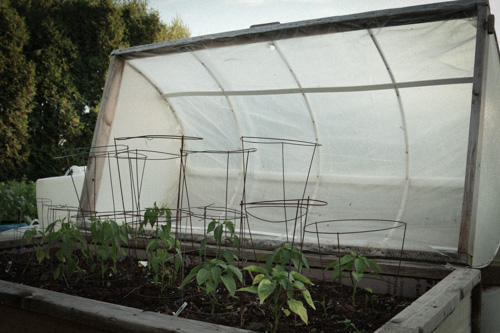 There’s another thing that has worked amazingly: the hoop house, for growing peppers. Peppers don’t like to be below fifty degrees. So, when it gets cool at night, you’ve got to cover them. And I actually made this hoop house with a double wall. When you have air between the two walls it acts as an insulator. Unfortunately one of the inner walls has ripped now.
There’s another thing that has worked amazingly: the hoop house, for growing peppers. Peppers don’t like to be below fifty degrees. So, when it gets cool at night, you’ve got to cover them. And I actually made this hoop house with a double wall. When you have air between the two walls it acts as an insulator. Unfortunately one of the inner walls has ripped now.
Jr: What is the material that the walls of the hoop house are made of?
Sr: It’s like a visqueen [plastic sheeting]. You use it in construction. I bought a roll of it.
Jr: It’s cool that you’ve used so many different materials. What are the different materials that you’ve built raised beds with? I can think of three off the top of my head.
Sr: I did use some treated wood. But the treated wood doesn’t touch the soil, because it’s lined with foam board. Then I actually caulked the joints so that the moisture from the bed wouldn’t get into the wall. If the sun hits the foam board though, it’ll deteriorate it. So I had some milkhouse board [a hard plastic material] and used that to cover the exposed foam board near the top of the soil. Now my new beds are way quicker to build, because I don’t have to do the three layers of wood, foam board, and milkhouse board.
Jr: What material do you use for your new beds?
Sr: They’re insulated aluminum panels for building screen rooms. They were actually ceiling panels.
Jr: And you made those panels into a raised garden bed. Is that your favorite thing that you’ve worked with or do you prefer to work with wood?
Sr: I love working with the wood, but I really think these will be the ticket. It’s my first year with them so we’ll see how they pan out. It’s working beautifully with the brassica plants [a family of vegetables including cabbage, broccoli, kale, and Brussels sprouts]. They’re just doing amazing. [He shows a picture of his thriving brassica plants in a raised bed made from the panels.] And the red ledge on there, that’s siding off of a house by church that they tore down.
Jr: Where do you get most of your materials?
Sr: Well, a lot of stuff I’ve accumulated just from being a landscaper. People don’t want stuff anymore, so I take it home. Like when I put in a new lawn, people will leave stuff lying by the dumpster because they can’t return it. For example, a sixteen-foot two-by-four, most people can’t haul it anywhere because it’s so long. So I just throw it on my trailer and bring it home.
Jr: Where did you get the paneling that you’re using?
Sr: From my friend Tom. He was actually going out of business, and he had all this inventory that he was just going to throw out, literally throw out. There are actually more of those panels too if you want some. That’s what my friend Marv used.
Jr: You said you have twenty-five raised vegetable gardens, not including flower planters. How much do you think it has cost you to build all those?
Sr: Probably . . . a couple of hundred bucks.
Jr: And it’s almost all reused material?
Sr: Well, I spent about fifty bucks on screws a long time ago; I gave you some! Those screws have built a lot of beds already. I’m not through half of them. They were half-priced on clearance. There was a big bucket of them. They’re expensive screws, and they work really nicely!
But with the panels, the biggest expense has been the caulking, because I’ve been trying to seal the edges. And when I put the ledge on, I seal that too.
Jr: So a couple of hundred bucks for twenty-five raised vegetable beds. That’s pretty good!
Sr: Well some of them are old tubs that I’ve pulled out of dumpsters. Or I see stuff that people just throw out, and I think, “Hey! A raised bed!”
Jr: I saw a large metal tube in the backyard, is that going to be raised garden?
Sr: Yeah, probably.
Jr: I really like the overturned playground tube [the kind a child would crawl through] that you turned into a raised bed. What are you growing in that?
Sr: Carrots! Last year I grew beans, this year carrots.
Jr: Do you think there’s something that inspired you to be a saver and reuser? Was it growing up that way?
Sr: Hmm. . . I think my dad instilled it in me. Like on rainy days, one of our jobs was to go in the shop and straighten nails. Then we’d reuse the nails.
Jr: Do you think grandma was also a good reuser?
Sr: Yeah, both of them inspired me.
Jr: It’s really neat. It’s a childhood lesson that has stayed with you that was really valuable.
Sr: Right, and when I was a kid, I used to think it was a dumb job, but it still left its impression.
Jr: So just in general, what do you love about gardening?
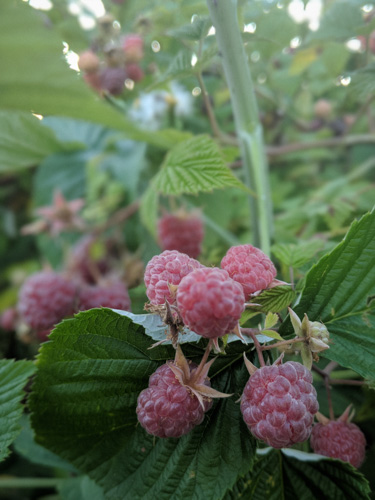 Sr.: I like to eat! I’m very proud of Mom because she has learned to fix what I grow. And on the other hand, I have also learned to grow what she likes. Like when we were younger in our marriage, I’d have all these vegetables, and she’d come home from the store. You kids all loved fruit, and she’d come home with grocery bags full of fruit. I thought, “Well what about these vegetables!” And She’d say, “Well, it’s on sale right now.” And I couldn’t argue with that, since you kids ate it. So, I didn’t take issue with it. But I was disappointed because we weren’t eating my vegetables. So in turn, I learned to grow fruit: blueberries, raspberries, watermelon, muskmelon. So, I changed my ways too; I didn’t just grow vegetables.
Sr.: I like to eat! I’m very proud of Mom because she has learned to fix what I grow. And on the other hand, I have also learned to grow what she likes. Like when we were younger in our marriage, I’d have all these vegetables, and she’d come home from the store. You kids all loved fruit, and she’d come home with grocery bags full of fruit. I thought, “Well what about these vegetables!” And She’d say, “Well, it’s on sale right now.” And I couldn’t argue with that, since you kids ate it. So, I didn’t take issue with it. But I was disappointed because we weren’t eating my vegetables. So in turn, I learned to grow fruit: blueberries, raspberries, watermelon, muskmelon. So, I changed my ways too; I didn’t just grow vegetables.
Also, I’ve really been stubborn about not using chemical fertilizers, it’s not that they’re bad, but I just figure if I grow it naturally, the food is going to taste better and be better for me. Like when I grow my sweet corn the only thing I put on it is chicken manure. Oh, here’s another trick for fertilizing. You just put something green in water and let it stand for three days. Then you water with that. It’s called tea.
Jr: What kind of greens do you use — dandelions and grass clippings?
Sr: Anything green. You just put it in water, let it stand, and when it starts to smell like poop, it’s good! That’s bacteria. You just try to work with nature. For example, I’ve got the cucumber beetles right now, and I thought “Boy, the sparrows love grain. Maybe the sparrows would eat the cucumber beetles too.” Maybe I should just start sprinkling some grain around the cucumbers and let the sparrows come and see if they’ll eat the cucumber beetles while they’re at it.
Jr: So you’re trying to figure out nature, not trying to force nature with our own methods.
Sr: Right, they have sticky traps too for the beetles, but I’m afraid you’ll end up with all kinds of things you don’t want in the sticky traps, such as bees.
Jr: Did someone inspire you to love gardening?
Sr: My mom, I would take gardening in 4H, and I would get blue ribbons on my vegetables, but it was my mom’s vegetables. I just helped in the garden, it was really her vegetables. Yeah, definitely my mom.
And dad too. Dad loved to grow the sweet corn. I can’t go out and hoe sweet corn without thinking of dad. It’s a good memory. You’ve planted my corn more than once. Isaac (Nathan’s brother) planted the second crop for me this year.
Jr: What is your advice for someone getting started?
Sr: Hmm. . . I don’t know. Keep it simple.
Jr: Just from what you’ve said, it doesn’t need to be made of anything fancy. Look in the dumpster, and hey there’s a raised garden bed.
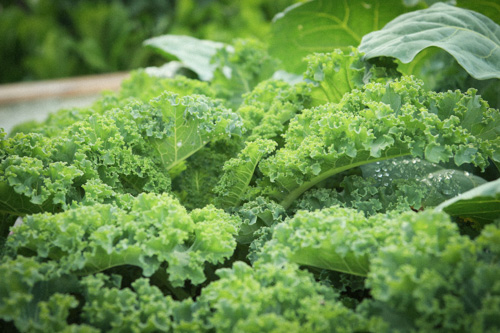 Sr.: Yeah, if you’re in a trade, use what you’ve got. If you are growing deep rooted plants, there are charts that tell you how deep your plant’s roots go. Don’t be too quick to water. In raised beds with an open bottom, deep rooted plants will go right down into the soil below where they’ll get plenty of water. So if you have a bed that’s eighteen inches high, and your plant has roots that go down eighteen inches, they’ll actually go right into the ground below the raised bed and get water. A good thing to do would be to get a soil probe to test for moisture about a foot down. If there is moisture a foot down, there’s really no need to water your plants. If your raised bed has a closed bottom, then you’ve got to water because the soil in the bed will dry up fast.
Sr.: Yeah, if you’re in a trade, use what you’ve got. If you are growing deep rooted plants, there are charts that tell you how deep your plant’s roots go. Don’t be too quick to water. In raised beds with an open bottom, deep rooted plants will go right down into the soil below where they’ll get plenty of water. So if you have a bed that’s eighteen inches high, and your plant has roots that go down eighteen inches, they’ll actually go right into the ground below the raised bed and get water. A good thing to do would be to get a soil probe to test for moisture about a foot down. If there is moisture a foot down, there’s really no need to water your plants. If your raised bed has a closed bottom, then you’ve got to water because the soil in the bed will dry up fast.
Jr: Anything else that you just want to share with people about gardening and reusing things?
Sr: I guess one thing is to always try different varieties of things. Just because you don’t get a good crop of this one year, doesn’t mean you won’t next year. If you have a good variety, you’ll get something. And use what you get. God gives you lemons, you make lemonade. Plant a good variety. Be willing to learn from your mistakes, because it’s a hard teacher but it’s a good one. You can go on the internet and watch all these videos on gardening, and they’re inspiring and they give you ideas and stuff, but the real test is out there: you learn from your labor. So don’t be afraid to get out there and work. Gardening is work, but it’s enjoyable work. It’s fruitful work.
